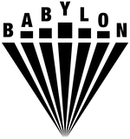ALICIA EGGERT'S AND MIKE FLEMING'S ETERNITY IN CYBERFEST'S EXHIBITION PROGRAM
Exhibition
-
The Unbearable Lightness was inspired by the artist's study of medieval and Renaissance stained glass windows in cathedrals around the world. She challenges the viewer, conditioned by the speed of contemporary media, to be open to a different optical and aesthetic experience.
This work is about an expectation of common computer/television user who is used to control and accelerate things in order to get to desired object/movie as quick as possible. The viewer is forced to feel the unbearable lightness of light coming out of this silent image, morphing slowly, too slowly compared to the pace of activities outside of the room, making viewers realize that everything in the familiar world around us is basically too fast.
Video installation by Alexandra Dementieva -
The River is a video installation for three projectors, based on YouTube excerpts. All these excerpts show women, who filmed themselves at home, while they were crying in despair because of love problems, health problems, existential problems, or whatever problems. It starts very quietly and it goes to a crescendo with yelling and screaming women, some doing self mutilation. They filmed themselves with their desperate 'messages in a bottle' and put this on YouTube as a last moment of hope for understanding and empathy.



Video installation by Koen Theys -
This art work belongs to a series of projects which explore the possibility of taking part in complex Systems from the integration of the spectator as a perturbing element in the behaviour of those systems.
This interactive installation response to behavioural rules for cellular automatons that were established by John Conway, who has named them “Game of Life”. This work incorporates the spectator, who can take part of that artificial life algorithm, changing the work state and the system behaviour.
“Game of life” is a system of cellular automatons, made up by 256 low-tech cells, that explores the man/machine relationship, materiality appropriating robotic electronic design and shape of an object with the possibility of a critical discourse from the use of low-tech technology within a scientific computing paradigm.

Interactive media installation by Leo Nunez -
Taxonomy is a mechatronic installation inhabited by mixed beings or, in the becoming, by technological animality, which defines their presence in depth of the screen it carries.
Screen, that reveal and hide at the same time. Surface, that shape the logic of the black box with an encoding to be deciphered whereas, what is at stake, is the very effectiveness of the device.
However, underlying such an extremely contemporary landscape marked by the scientific-technical display of the image and, as a way of mediation between the subject and its environment, once again, the mythology.

Media installation by Mariela Yeregui & Miguels Grassi -
In the video Those Who Go And Those Who Stay Behind, the artist recorded people embarking on the boats in Venice during the Sunday rush hour, in July and August. Human traffic is regulated by the mariner who opens and closes access to the boat with a chain, blocking the flow when necessary. So as not to influence the spontaneity of people's actions and reactions, I organised things in a way that they could not understand whether the video camera was working or not. Manners, movements and expressions distinguished those who departed from those left behind.
Again, we have the record of a micro phenomenon that conveys a universal meaning of the human condition where the specific case becomes emblematic.
Still from video installation Those Who Go And Those Who Stay Behind by Mariateresa Sartori Sartori -
Stairs is a functional item, providing vertical connections. It is often used as a symbol, emphasising the importance of climbing, and a part of a religious ritual.
In this installation artist depict a 'box' with the projections of stairs going indefinitely up and coming down. They are reflected in the mirrors of the ceiling and the floor, so movements on them change their direction. The audience appears to be in perpetual movements, remaining still just for a few moments. And that is important for the artists, as a person can experience that moment of quiescence in the process, that could be the gateway from the known and weekdays boredoms.

Video installation by Elena Gubanova and Ivan Govorkov -
Anna Frants creates installations that allude to the passage of time, power of memory and tactile and tangible interaction. This work is а large-scale installation that is crossing boundaries between art, design and cinema. Like all of Anna Frants’ works, this installation is part fantasy and part instinctive immersion bound by programming and robotics.
-
All 36 clock hands align to spell the word “ETERNITY” once every 12 hours.
Documentation by Mike Fleming -
Natalya Lyakh's sight is similar to the sight of an optician, as she uses the camcorder as a telescopic or even microscopic periscope in her work, which gets into the secret lives of everyday things and their reflections, distortions and transformations, that occur without special effects, but only through the sight and sound.
In video installations Untitled N 1, 2 the artist explores and creatively interprets transformations of the water and inside of it. Water remains an important part of various mythologies, is often associated with the subconscious and considered the initial state of things, the source of life. There's a hidden knowledge in its depths, that is impossible to get for a human, but is available for a fish. Ancient Semites had a deity in the form of a fish named Dagon, which can mean «fish», «guardian» and even «messiah».
Video installation by Natalya Lyakh -
A street-organ is a common mobile abode full of tales, unfolding with a turn of the handle. A whole world lives inside a fanciful interior of a street-organ (Katarinka, as they were called in Russia). Seemed like this sweet and touching part of a street culture has disappeared completely. But for now, when they've been raised with the aids of modern technology.
Looking antique from the outside Katarinka includes cutting edge technologies inside. There is a strong feeling of seeing a hologram with images being projected on semi-transparent screens carefully mapped on the city model. Spectators turn the handle, listening to gentle melodies and trying to understand, what's happening inside this little world.
Visit exhibition program at Creative space TKACHI (Obvodny Canal, 60) and ART re.FLEX gallery (Prospekt Bakunina, 5).






















